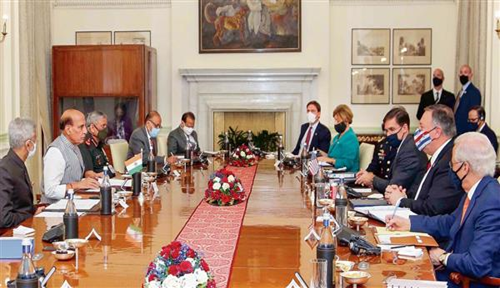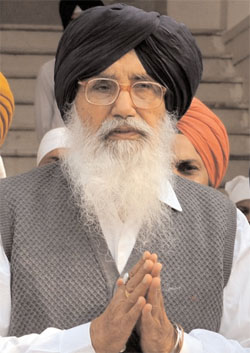
Blurb
The optics around the 2+2 Dialogue

in Delhi are defining — the defense ties between the two countries have come of age
Sidebar
The signing, last week, of the Basic Exchange and Cooperation Agreement (BECA) providing for the sharing of geospatial data is the last of the foundational agreements. The first, General Security Of Military Information Agreement (GSOMIA), relating to security of each other’s military information was signed in 2002. The Congress-led United Progressive Alliance government signed the End Use Monitoring Agreement (EUMA) in 2009. The India–United States defense partnership received a major boost earlier this week with the visit of U.S. Secretary of State Mike Pompeo and U.S. Defense Secretary Mark Esper for the third round of the 2+2 Dialogue with their Indian counterparts, External Affairs Minister S. Jaishankar and Defense Minister Rajnath Singh. The joint statement spells out the highlights but the optics are what define the visit. At a time when most ministerial engagements and even summits are taking place virtually, the significance of two senior U.S. officials travelling to Delhi a week before the U.S. goes to the polls conveys an unambiguous political message — the defense partnership has come of age.
A long road
It has been a long process, with many ups and downs since the first modest steps were taken with the end of the Cold War three decades ago. The 1991 Kicklighter proposals (Lt. Gen. Claude Kicklighter was the Army commander at the U.S. Pacific Command) suggested establishing contacts between the three Services to promote exchanges and explore areas of cooperation. An Agreed Minute on Defense Cooperation was concluded in 1995 instituting a dialogue at the Defense Secretary level together with the setting up of a Technology Group.
The end of the Cold War had helped create this opening but the overhang of the nuclear issue continued to cast a shadow on the talks. There was little appreciation of each other’s threat perceptions and the differences came to a head when India undertook a series of nuclear tests in 1998. The U.S. responded angrily by imposing a whole slew of economic sanctions and leading the international condemnation campaign. An intensive engagement followed with 18 rounds of talks between the then External Affairs Minister, the late Jaswant Singh, and then U.S. Deputy Secretary of State Strobe Talbott spanning two years that helped bring about a shift in perceptions. Sanctions were gradually lifted and in 2005, a 10-year Framework for Defense Relationship established, followed by a Joint Declaration on Defense Cooperation in 2013. The Framework agreement was renewed in 2015 for another decade.
The Framework laid out an institutional mechanism for areas of cooperation including joint exercises, intelligence exchanges, joint training for multinational operations including disaster relief and humanitarian assistance, technology transfer and a sharing of non-proliferation best practices. Initial movement was slow; it gathered momentum once the nuclear hurdle was overcome in 2008 with the India-U.S. civil nuclear deal.
There were other factors at play too. Equally important was the progressive opening up of the Indian economy that was registering an impressive annual growth rate of over 7%. Bilateral trade in goods and services was $20 billion in 2000 and exceeded $140 billion in 2018. The four million-strong Indian diaspora in the U.S. has come of political age and its impact can be seen in the bipartisan composition of the India Caucus (in the House) and the Senate Friends of India group. From less than $400 million of defense acquisitions till 2005, the U.S. has since signed defense contracts of $18 billion.
A bipartisan consensus
A bipartisan consensus supporting the steady growth in India-U.S. ties in both New Delhi and Washington has been a critical supporting factor. The first baby steps in the form of the Kicklighter proposals came in 1991 from the Bush administration (Republican) when P.V. Narasimha Rao led a Congress coalition. Following the nuclear tests, Prime Minister Atal Bihari Vajpayee (Bharatiya Janata Party) welcomed President Bill Clinton (Democrat) to Delhi. The visit, taking place after 22 years — the previous one being U.S. President Jimmy Carter’s visit in 1978 — marked a shift from “estranged democracies” to “natural allies”. A Congress coalition led by Prime Minister Manmohan Singh carried the process forward with a Republican Bush administration. Heavy political lifting was needed to conclude the historic nuclear deal in 2008, removing the biggest legacy obstacle.
The biggest push has come from Prime Minister Narendra Modi overcoming the “hesitations of history” and taking forward the relationship, first with a Democratic Obama administration by announcing a Joint Strategic Vision for the Asia-Pacific and Indian Ocean Region in 2015, followed by elevating the India-U.S. Strategic and Commercial Dialogue (launched in 2009 and the first round held in 2010) into the 2+2 dialogue in 2018 with the (Republican) Trump administration reflecting the ‘Comprehensive Global Strategic Partnership’. Mr Modi is not constrained (at least on the strategic side) unlike Dr. Singh during his second term who faced opposition within his party, had a Defense Minister who preferred to shy away from any decision, and often had to prod a reluctant bureaucracy.
The signing, last week, of the Basic Exchange and Cooperation Agreement (BECA) providing for the sharing of geospatial data is the last of the foundational agreements. The first, General Security Of Military Information Agreement (GSOMIA), relating to security of each other’s military information was signed in 2002. The Congress-led United Progressive Alliance government signed the End Use Monitoring Agreement (EUMA) in 2009 but then dragged its feet on the others on the grounds that it would jeopardize India’s strategic autonomy. However, it was apparent that as military exercises with the U.S. expanded, both in scale and complexity, and U.S. military platforms were inducted, not signing these agreements was perceived as an obstacle to strengthening cooperation. Nearly 60 countries have signed BECA. In 2016, Logistics Exchange Memorandum of Agreement (LEMOA) relating to exchange of logistics support had been concluded, followed by Communications Compatibility and Security Agreement (COMCASA) in 2018 permitting encryption standards of communication systems. More than 100 countries have signed these agreements with the U.S. Equivalent agreements on logistics and mutual security of military communication have also been signed with France but without the political fuss.
Breaking away from ‘labels’
Developing the habit of working together has been a long process of building mutual respect and trust while accepting differences. The U.S. is used to dealing with allies (invariably junior partners in a U.S.-dominated alliance structure) and adversaries. India falls into neither category. Therefore, engaging as equal partners has been a learning experience for both India and the U.S. Recognizing this, the U.S. categorized India as “a Major Defense Partner” in 2016, a position unique to India that was formalized in the National Defense Authorization Act (2017) authorizing the Secretaries of State and Defense to take necessary measures. It has helped that India also joined the export control regimes (Australia Group, Missile Technology Control Regime and Wassenaar Arrangement) and has practices consistent with the Nuclear Suppliers Group where its membership was blocked by China spuriously linking it to Pakistan. In 2018, India was placed in Category I of the Strategic Trade Authorization, easing exports of sensitive technologies.
In every relationship, there is a push factor and a pull factor; an alignment of the two is called the convergence of interests. An idea matures when the timing is right. After all, the Quad (Australia, India, Japan and the U.S.) was first mooted in 2007 but after one meeting, it petered out till its re-emergence now. Alongside the ministerial meeting in Tokyo earlier this month, India was invited for the first time to also attend the Five Eyes (a signals intelligence grouping set up in 1941 consisting of Australia, Canada, New Zealand, the United Kingdom and the U.S.) meeting.
The policy debate in India is often caught up in ‘labels’. When Prime Minister Jawaharlal Nehru described non-alignment as the guiding principle of Indian foreign policy, it was designed to expand India’s diplomatic space. Yet, in 1971, when the Cold War directly impinged on India’s national security, a non-aligned India balanced the threat by signing the Treaty of Peace, Friendship and Cooperation between the Government of India and the Government of the Union of Soviet Socialist Republics. However, during the 1970s and 1980s, it was often hijacked by the Non-aligned Movement tying up policy in ideological knots. Such became the hold of the label that even after the Cold War, India defined strategic autonomy as Non-alignment 2.0! The Indian strategic community needs to appreciate that policies cannot become prisoners of labels. Ultimately, the policy objective has to enhance India’s strategic space and capability. That is the real symbolism of the in-person meeting in Delhi.
(The author is a former diplomat and presently Distinguished Fellow at the Observer Research Foundation)
(Source: The Hindu)





Be the first to comment